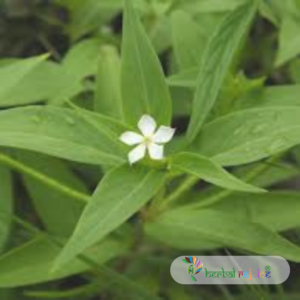Introduction
Vinca pusilla Murr is a plant belonging to the family Apocynaceae. It is commonly found in West Bengal and throughout most parts of India as a weed. In Ayurveda, it is known as Sangkhi or Sangkhaphuli, and in folk medicine, it is called Milagaipoondu in Tamil Nadu, Kapavila in Kerala, Vishakanegale in Karnataka, Neru in Andhra Pradesh, and Mirchaai in Bihar.
Medicinal Properties
This plant has been traditionally used for its oncolytic properties, which means it helps in the resolution of tumors. In the treatment of lumbago, a decoction of the dried plant boiled in oil is commonly used.
Chemical Constituents
Vinca pusilla Murr contains various compounds that contribute to its medicinal properties. These include ajmalicine, rauwolscine, vindoline, pusiline, and pusilinine. Additionally, the leaves of the plant have been found to contain leurosine, lochnerinine, venoterpine, vindorosine, and vincapusine.

The root of the plant also contains lochnericine. Of these compounds, leurosine has been found to have cytotoxic effects, while pusiline and pusilinine have been observed to cause notable depression of the heart.
Conclusion
In conclusion, Vinca pusilla Murr is a valuable plant with oncolytic properties and is traditionally used in the treatment of lumbago. Its various compounds contribute to its medicinal benefits, and further research is needed to explore its full potential in the field of medicine.
Frequently Asked Questions
What is Vinca pusilla Murr?
Vinca pusilla Murr is a plant belonging to the Apocynaceae family, commonly found in West Bengal and throughout India.
What are the common names of Vinca pusilla?
In Ayurveda, it is known as Sangkhi or Sangkhaphuli. In folk medicine, it’s called Milagaipoondu in Tamil Nadu, Kapavila in Kerala, Vishakanegale in Karnataka, Neru in Andhra Pradesh, and Mirchaai in Bihar.
What are the medicinal uses of Vinca pusilla?
Vinca pusilla has been traditionally used for its oncolytic properties, helping in tumor resolution and treating lumbago with a decoction boiled in oil.
What compounds are found in Vinca pusilla?
Key compounds include ajmalicine, rauwolscine, vindoline, pusiline, and pusilinine, as well as leurosine, lochnerinine, venoterpine, vindorosine, and vincapusine.
What are the effects of leurosine?
Leurosine has been found to exhibit cytotoxic effects, indicating its potential in cancer treatment.
How does Vinca pusilla help with lumbago?
A decoction of the dried plant boiled in oil is commonly used to relieve the pain associated with lumbago.
What is the significance of the oncolytic properties of Vinca pusilla?
Its oncolytic properties suggest that the plant may assist in reducing or eliminating tumors, making it of interest in cancer research.
Can Vinca pusilla be used in modern medicine?
Yes, further research is needed to validate its medicinal properties and explore its potential applications in modern medicine.
Are there any side effects associated with Vinca pusilla?
Some compounds, like pusiline and pusilinine, may cause notable depression of the heart. Caution is advised when using this plant.
Is Vinca pusilla safe to consume?
While traditionally used, it’s important to consult a healthcare provider before using Vinca pusilla, especially for medicinal purposes.
Where can Vinca pusilla be found?
It is primarily found in West Bengal and various regions across India as a weed.
What traditional practices utilize Vinca pusilla?
It has been used in Ayurvedic and folk medicine for various ailments, particularly for tumor resolution and pain relief.
Is there scientific research on Vinca pusilla?
Yes, ongoing research aims to uncover its medicinal properties and potential applications.
How is Vinca pusilla prepared for medicinal use?
The dried plant is often boiled in oil to create a decoction for treating lumbago.
What types of cancer might Vinca pusilla help treat?
Preliminary studies suggest potential benefits in inhibiting tumor growth, but more research is needed to specify types.
Are there any contraindications for using Vinca pusilla?
Individuals with heart conditions should use caution due to its potential effects on heart function.
How does Vinca pusilla compare to other medicinal plants?
Vinca pusilla has unique oncolytic properties and a distinct chemical profile, making it different from many other medicinal plants.
Can Vinca pusilla be cultivated?
Yes, it can be cultivated, but it is essential to ensure proper identification and sourcing.
What is the traditional preparation method for Vinca pusilla?
Traditionally, the dried plant is boiled in oil to create a decoction used for medicinal purposes.
Why is further research important for Vinca pusilla?
To validate its traditional uses and explore its pharmacological potential, ensuring safety and efficacy in clinical applications.


